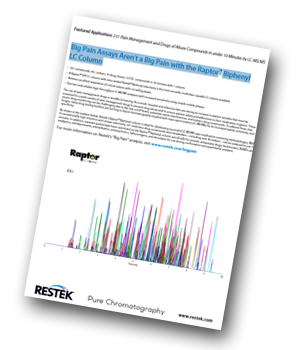 Restek has produced an application note demonstrating how its Raptor™ Biphenyl column is ideal for developing successful LC-MS/MS pain medication screening methodologies. As a result big pain assays no longer become a big pain.
Restek has produced an application note demonstrating how its Raptor™ Biphenyl column is ideal for developing successful LC-MS/MS pain medication screening methodologies. As a result big pain assays no longer become a big pain.
Introduction
The use of pain management drugs is steadily increasing. As a result, hospital and reference labs are seeing an increase in patient samples that must be screened for a wide variety of pain management drugs to prevent drug abuse and to ensure patient safety and adherence to their medication regimen. Therapeutic drug monitoring can be challenging due to the low cutoff levels, potential matrix interferences, and isobaric drug compounds. To address these challenges, many drug testing facilities are turning to liquid chromatography coupled with mass spectrometry (LC-MS/MS) for its increased speed, sensitivity, and specificity.
In addition, separate panels have been optimized on the Raptor™ Biphenyl column specifically for opioids, antianxiety drugs, barbiturates, NSAIDs and analgesics, antidepressants, antiepileptics, antipsychotics, hallucinogens, and stimulants for use during confirmation and quantitative analyses.
Key Advantages of Using the Raptor™ Biphenyl Column
- 231 compounds, 40+ isobars, 10 drug classes, 22 ESI- compounds in 10 minutes with 1 column
- Greater versatility
- Excellent separation of critical isobars with no tailing peaks
- Ability to run fast and reliable high-throughput LC-MS/MS analyses with increased sensitivity using simple mobile phases.




